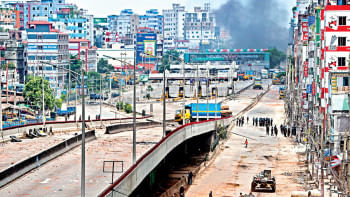Participation increases, discrimination remains
The participation of Bangladeshi women in labour force has increased over the years, but the terms of their participation in the labour market are still discriminatory, according to a report of Asian Development Bank (ADB).
Their participation increased to 33.5 percent in 2013 from 26.1 percent in 2002-2003, but 90.3 percent of them are employed in the informal sector, according to the report, "Bangladesh Gender Equality Diagnostic of Selected Sectors", revealed yesterday at a hotel in the capital.
ADB prepared the report in collaboration with the Brac Institute of Governance and Development. ADB Country Director for Bangladesh Manmohan Parkash was present.
Women's participation in labor force is lagging behind in the formal sector and urban areas due to a lack of education and skill, the report finds.
In the urban areas, 25.7 percent of women are employed in the formal sector and 74.3 percent in the informal sector. On the other hand, in the rural areas, 8.3 percent are employed in the formal sector while 91.7 percent in the informal sector.
“Women are overrepresented in both the informal and rural sectors which are by lower returns, greater insecurity, and generally unfavorable working conditions,” said the report.
The number of total women employed in the job market was 1.68 crore in 2013 and it was 1.12 crore in 2005, according to the report.
Though, gender gap in income narrowed over the decade but there is still a wider wage gap in urban areas. In 2013, the monthly income for men was Tk 11,621 and women Tk 11,136. In the urban areas, the wage for men Tk 14,186 and for women Tk 12,312, data shows.
The number of unpaid domestic female helpers grew steadily from 47 lakh in 2002-2003 to 84 lakh in 2013. On the contrary, the number of men working as unpaid domestic labour declined from 34 lakh in 2002-2003 to 21 lakh in 2013.
Referring to a survey carried out by the Bureau of Statistics in 2011, the report points out that as many as 87 percent of currently married women reported experiencing some kind of violence during the previous 12 months.
The report finds that the country has generally made rapid progress on several social and economic indicators. For example, while the maternal mortality ratio remains higher than the 2015 Millennium Development Goal of 143, it has fallen from 472 deaths per 100,000 live births in 1990 to 181 in 2015.
Likewise, the proportion of employed women with no formal schooling almost halved from around 41 percent in 2010 to around 21 percent in 2013. The proportion with higher secondary education and degrees rose noticeably, as the employed female population has become more skilled. However, women's access to technical and vocational training is less positive, with only 28 percent of students enrolled.
Women's educational and work opportunities are hampered by a lack of reliable, safe, and economical public transport, the report says. Energy is also critical to women's empowerment and development because access to clean and affordable energy services is a precondition for improved women's health, children's ability to study, and women's livelihood opportunities.

 For all latest news, follow The Daily Star's Google News channel.
For all latest news, follow The Daily Star's Google News channel. 



Comments